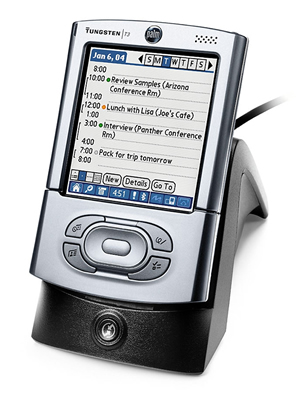Palm’s new Tungstens: a first look

Tungsten T3
At the higher end, the Tungsten T3, which debuts at £349 (inc. VAT), is the third product in the Tungsten Tx range. It pushes the envelope of the Palm concept while retaining some of its predecessors’ best features. The 400MHz Intel XScale processor is top of the line, and Palm has finally emulated Sony’s efforts with screen resolution: now, when you pull down the characteristic Tungsten Tx slider, instead of the Graffiti area seen in previous models, you get more screen: 480 pixels of depth alongside 320 pixels of width. Graffiti is available as a software overlay if required.

Another key feature of the Tungsten T3 is native support for flipping the screen into landscape mode, the better to read spreadsheets, Web pages and so on (and, says Palm, to watch movies).
Palm seems shy of prescribing an audience for this device: the Tungsten T3’s 16MB of ROM contains professional-level tools like Documents To Go 6, along with more leisure-orientated applications such as the RealOne media player and Kinoma video player. The ROM also contains Palm’s VersaMail, which should prove useful in conjunction with the device’s built-in Bluetooth. However, Palm’s Web browser will have to be installed to RAM -- of the 64MB complement that Palm provides, 52MB is available to the user. The battery should last for around five days of average use, according to Palm. Anyone who has recently bought a Tungsten T2 will be disappointed that this new model offers so much more -- and Palm may have compounded that issue by refusing to offer a ROM upgrade to owners of older handhelds.
Tungsten E
The Tungsten E (Palm says there’s no particular reason for this choice of letter) is more of an entry-level device. The processor is a Texas Instruments OMAP running at 126MHz, and the Tungsten E’s display measures 320 by 320 pixels. Because the screen is pretty much square, the Tungsten E doesn’t support the switch to landscape mode offered on the T3. Nor does it have the new Status Bar. A number of tweaks to the core PIM applications are implemented in both new Tungstens, though. These are covered in a separate story.
The Tungsten E ships with a docking cable rather than a cradle -- a measure that has helped keep the retail price down to a very competitive £149 (inc. VAT). It has 32MB of memory, and benefits from a sleek hardware design, weighing in at 131g. Although it’s not particularly special in terms of features, the Tungsten E comes in at a good price and newcomers to the handheld market may be tempted by it. The accessories span a range of cases, pens and suchlike. None are especially exciting -- a stylus with built-in light, a pen/stylus combination with a built-in laser and a gold-plated stylus are among the highlights. The Tungsten T3 looks set to be the headline grabber: clever hardware design along with a number of solid software developments should see it become a popular device.